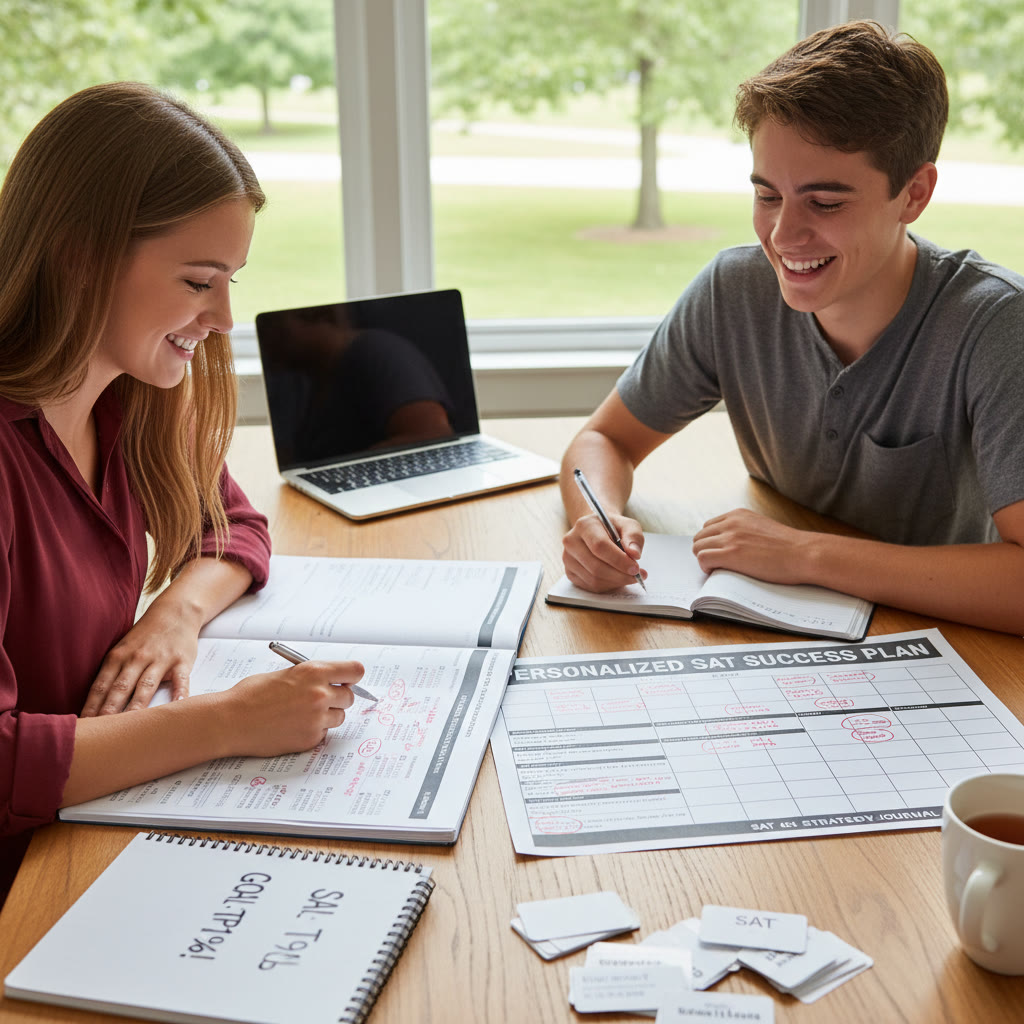The Ideal Frequency of Practice Tests for SAT Students
Ask most students prepping for the SAT and you’ll hear a version of the same question: how often should I take a full practice test? The short answer is: it depends. The longer answer — the one that actually helps — considers how much time you have, where you’re starting from, what score you need, and how you learn best. In this guide I’ll lead you through a sensible, evidence-informed plan for practice-test frequency, practical weekly schedules, and how to read the results you get so each test moves you closer to your target score.

Why practice tests matter more than you think
Practice tests do several jobs at once. They’re diagnostic, they build test stamina, they teach time management and pacing, and they create opportunities to learn from realistic mistakes. A single practice test tells you what you don’t know; taken regularly and reviewed carefully, practice tests show what you’ve learned. Think of them like workouts for the brain: you don’t get stronger by running one mile once — you get stronger by running, analyzing your performance, adjusting, and repeating with intent.
Common myths about practice-test frequency
- Myth: More tests = better results. Fact: Quality beats quantity. Without focused review and targeted practice, repeating tests just repeats the same errors.
- Myth: Take a test every week. Fact: For some students, weekly tests are perfect; for others, especially beginners or those short on time, they’re overwhelming and unproductive.
- Myth: Practice tests only help with timing. Fact: They also improve strategy, confidence, and your ability to handle test stress.
How frequency depends on your timeline
Below are practical recommendations keyed to how far away your test date is. Use these as starting points and adapt to your energy, schedule, and learning needs.
| Time Until Test | Recommended Full-Length Practice Tests | Focus |
|---|---|---|
| 6+ months | 1 every 2–3 weeks | Baseline diagnostics, build habits, content review |
| 3–6 months | 1 per week or 2 every 3 weeks | Progress tracking, targeted practice, pacing |
| 1–3 months | 1 per week | Simulate test conditions, refine timing, review mistakes thoroughly |
| Last 4 weeks | 2 per week in week 1–2, taper to 1 then 0–1 | Polish strategy, build stamina, reduce burnout |
| Last week | 0–1 light practice (no exhausting full test) | Rest, quick review, confidence building |
These are guidelines, not laws. If a test leaves you raw and unproductive for several days, cut back. If you’re the kind of student who thrives on data, a slightly higher cadence might work — as long as each test is followed by rigorous review.
Designing a practice-test schedule that works
Designing the right cadence starts with three questions:
- How much time do you have until the test?
- What’s your baseline score and target score?
- How well do you learn from mistakes versus repetition?
A sample 12-week schedule (target: +120 points)
This is a balanced, hands-on approach for a student with about three months until test day. It includes full practice tests, targeted practice, and strategic rest.
| Week | Full-Length Tests | Other Practice | Primary Focus |
|---|---|---|---|
| 1 | 1 (diagnostic) | Daily short practice (30–45 min) | Baseline, weak area identification |
| 2 | 0 | 3 days targeted sections; 2 days mixed practice | Content building |
| 3 | 1 | Review test; drill weaknesses | Apply lessons learned |
| 4 | 0 | Timed section practice; strategy work | Pacing |
| 5 | 1 | Full review; mixed practice | Progress check |
| 6 | 0 | Targeted drills; vocabulary and math fundamentals | Solidify foundation |
| 7 | 1 | Review; practice essays (if applicable) | Strategy refinement |
| 8 | 0 | Timed sections and practice sets | Consistency |
| 9 | 1 | Full review; polish weak areas | Final adjustments |
| 10 | 2 | Short practice only | Peak performance simulation |
| 11 | 1 | Light review | Taper |
| 12 | 0–1 (light) | Rest, confidence-building drills | Recovery and focus |
This plan deliberately alternates heavy and light weeks. That’s because a practice test is most valuable when you have time to review it fully. If you take tests back-to-back without review, you burn energy without learning much.
How to review a practice test so it actually helps
Review is where the learning happens. Spend at least as much time reviewing a test as you did taking it — often longer. Here’s a simple review workflow to follow after each full practice test:
- Quick scoring: mark answers and get a raw score so you know where you stand.
- Categorize errors: content mistake, careless error, timing/omission, strategy mistake.
- Targeted drill: for each content mistake, do 3–5 focused practice problems on that topic.
- Strategy tweak: if timing or strategy caused mistakes, practice the specific tactic (e.g., passage skimming, algebra shortcuts).
- Journal takeaways: write 3–5 clear action items to guide the next week’s practice.
Example: from error to action
Suppose you missed five algebra questions and two sentence-structure questions. Don’t simply mark them wrong and move on. Drill algebra fundamentals for 30–45 minutes the next day, focusing on the exact type of algebra (e.g., linear systems or quadratic manipulation). For the sentence-structure errors, practice similar sentence correction questions with attention to parallel structure and pronoun agreement. Your goal is to convert errors into a predictable, repeatable set of steps you can practice until they feel automatic.
Balancing quantity and quality
Many students fall into a ‘more is better’ trap. This can show up as endless practice tests with little learning or shallow review. Here’s a rule of thumb: if you are taking more than one full practice test per week, ask whether you are doing deep review after each one. If not, reduce frequency and replace tests with targeted practice sessions that address persistent weaknesses.
When ramping up makes sense
- You have a short time until the test and need to simulate real conditions.
- You consistently review and see clear incremental gains.
- You’re practicing under a coach or tutor who helps interpret results.
That last point matters. Students paired with focused coaching — whether in-person, virtual, or through personalized services like Sparkl’s tutoring — often benefit from a slightly higher testing cadence because their review is more efficient. Sparkl’s personalized tutoring provides 1-on-1 guidance, tailored study plans, and expert tutors who can convert test data into actionable adjustments. If you’re working with a tutor who helps you identify patterns, a weekly or twice-weekly practice-test rhythm might be sustainable and highly productive.
How to avoid burnout while maintaining progress
Intensity without recovery leads to exhaustion. If you’re feeling drained, fuzzy-headed, or demotivated, scale back. Here are ways to maintain momentum without burning out:
- Swap a full test for timed sections once in a while. Two timed sections take much less energy and still build pacing skills.
- Use low-energy days for lighter tasks: flashcards, core concept review, or reading practice passages for comprehension rather than speed.
- Schedule one full rest day each week—no SAT work. Your brain consolidates learning during rest.
Final-week strategy
In the final week before the test, focus on calm, confident review. Avoid heavy new material. Instead, do short targeted sessions focused on the most common question types you struggle with. One light practice test early in the week can be helpful, but plan to taper so you arrive on test day rested and sharp.
Tracking progress: what to watch for
Practice-test frequency should produce measurable progress. Watch these markers:
- Consistent upward trend in section scores over several tests.
- Fewer careless/formatting/timing errors.
- Faster, more confident pacing on previously slow question types.
- Ability to handle a full test without mental collapse.
If you’re plateauing, change the inputs: swap practice-test frequency, try a different review strategy, or bring in targeted help. That’s where a personalized tutor can add real value. Sparkl’s expert tutors provide tailored study plans and AI-driven insights that flag stubborn patterns and recommend focused drills — so every practice test becomes more meaningful.
Practical checklist before each practice test
- Set a realistic time window (no interruptions, simulate test day).
- Use a test-day kit: pencils, timer, scratch paper, quiet room.
- Decide on a review time slot immediately after the test — ideally the same day.
- Record your score, feelings, and key takeaways in a short study journal.
Wrapping up: a flexible rule of thumb
Here’s a simple, flexible rule of thumb to carry with you: take practice tests frequently enough to gather useful data and build stamina, but not so frequently that you can’t or won’t review them properly. For most students, that means:
- Early prep (6+ months out): 1 every 2–3 weeks.
- Focused prep (1–3 months out): about 1 per week.
- Peak weeks (2–4 weeks before test): increase to 1–2 per week but taper in the final days.
Finally, test frequency isn’t a substitute for focused learning. Pair your practice-test schedule with deliberate study: targeted drills, concept reviews, and strategy sessions. And if you need help translating test results into an effective study plan, consider working with dedicated tutors. Sparkl’s personalized tutoring offers 1-on-1 guidance, tailored study plans, and AI-driven insights that turn each practice test into a stepping stone rather than a scoreboard.
Parting thought
Think of practice tests as a conversation between you and the exam: each test tells you something, and your job is to listen, respond, and improve. With intentional frequency, smart review, and a recovery plan, you’ll reach test day calmer, smarter, and ready to perform at your best.

Enjoy the process. The SAT is one event in a bigger story. Use practice tests to learn about how you think under pressure, where you can grow, and what strategies fit you best — and let that knowledge carry you beyond the day of the exam.


















No Comments
Leave a comment Cancel